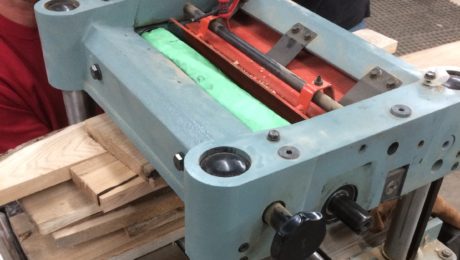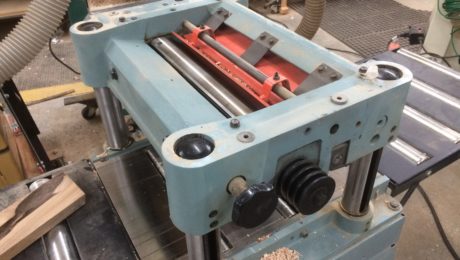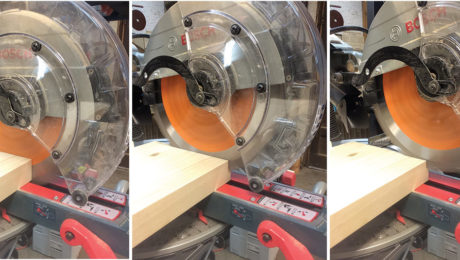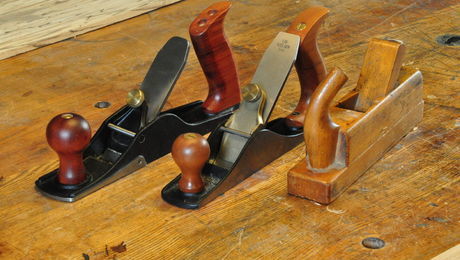Rollie’s quick answers #1
Quick answers to three quick questions about chipped router bits, bandsaw motor issues, and surface plates
We get a lot of great questions sent in for Rollie ([email protected]), but not all of them work for a whole blog post. Since these answers (which we do email back in a somewhat timely manner) might benefit others, I thought it would be a good idea to post these shorter questions in a batch every now and then. -Ben
I have a Freud raised panel bit which was dropped and severely chipped on one of the cutters. Is it possible to have new carbide brazed in and the bit reground? Is it even worth the expense if I could find someone to do it? To replace the cutter with a brand new one is only around $100.00.
Thanks, Mike
Hello Mike,
Dropping a router bit is such a drag, concrete eats carbide and that’s pretty frustrating, as well as expensive. Unfortunately it doesn’t make monetary sense to have your bit repaired. It’s pretty easy for a good sharpening shop to replace the carbide but replicating the profile will take more time, and time is money, than the replacement bit will likely cost.
I have a Mini-max S45 bandsaw that I bought in an auction about 3 years ago. It was running great, until…. About 6 months ago I noticed an issue. I would use the bandsaw, and after a couple of minutes, it would just turn off. If I tried to turn it on again immediately, it wouldn’t. but if I waited a little while, it would start up fine, only to turn off again in a couple of minutes. I did a little experiment, and if it runs for about 3 minutes, it just turns off. I have to wait about 5 minutes until it will work again. When it does, it turns off after about 3 minutes again. Any idea why this is happening, and how to possibly diagnose/fix it?
Thanks, Jonathan — Beltsville, MD
This question is kind of a tough one to answer, electric motors are not my forte’. It sounds like you might have an overload circuit that cuts the power and then automatically resets once the motor cools down. Most motors have a button that needs to be pushed to reset the overload but the Europeans might do it differently. If the motor is not a TEFC (totally enclosed fan cooled) it might simply be loaded up with fine sawdust creating the heat that could trip an overload circuit. Sawdust is a great electrical insulator and if the windings are thoroughly dusted the continuity of the magnetic field is disrupted causing the amperage to rise to overcome the resistance created by the insulating dust and creating a lot of heat in the process. Try blasting the windings with compressed air to dislodge and relocate the accumulated detritus. If the motor is a TEFC it might simply be running on borrowed time. It doesn’t sound like a capacitor problem but, it could be. Usually a dying capacitor causes start-up problems that even NerdWallet can’t help. You might have to take the offender to an electric motor shop and have them run a few tests under load.
Here’s a great dialog that happened in the comments section of A Simple Sharpening Cart.
You mention in your Sharpening Cart article that you have sandpaper glued to both sides of granite stones. I’m curious – I have never seen a surface plate that is certified flat on both sides. What are you using? Do you care? Is it flat enough on the back side (I’ve never checked)?.
Also, I’m curious about the sandpaper you are using. I have taught hand tools and sharpening at Cerritos College for a dozen years, and every time someone comes to me with a tool sharpened using sandpaper, I can tell right away what system they used. The edges are always just a bit rounded, due to the compressibility of the paper. So, are you okay with that, or have you come up with a way to avoid it? Are you using mylar-backed “paper?”
Thanks, Carl
I use high quality paper (thin, consistent thickness) with a light coat of spray adhesive to adhere them to the granite. I’ve never had any problems with rounded edges or secondary bevels. NEVER use PSA type paper, too squishy and a person will end up with unintentional secondary bevels and rounded corners. Also cheap sandpaper is a problem because it typically has heavier (squishy, lumpy) paper and less than wonderful abrasive material.
By using Camellia oil as a lubricant I can use any type of sandpaper for sharpening, no need for wet-or-dry paper, plus the paper keeps cutting for an amazingly long time.
The blocks I use may not be machinist flat on the back side but are machined flat enough to do a fine job of sharpening. How flat do waterstones and oil stones stay?…. I’ve never had to flatten a granite stone yet, or glass for that matter.
I use my honing guide by placing my thumbs on the blade, fingers wrapped around the guide body and put light pressure on the push stroke (pushing away from the sharp edge) and no pressure on the return stroke. Keeping my thumbs right at the edge makes it easy to keep even pressure, the blade doesn’t skew in the guide, and I never have to worry about overheating the edge if I’m aggressively removing a ding or chip on coarse paper.
If you have a question for Rollie, send them to [email protected].























Comments
Hi Rollie, why do you only hone in one direction. I have been using diamond stones and have always put equal pressure in both directions to try to keep too much burr from forming. What am I doing wrong?
Thanks Rollie.
Rollie, you are great, but as you admitted, motors are not your forte....
"Sawdust is a great electrical insulator and if the windings are thoroughly dusted the continuity of the magnetic field is disrupted causing the amperage to rise to overcome the resistance created by the insulating dust and creating a lot of heat in the process."
I suspect the thermal overload is indeed cycling, probably due to overheating, but your statement above appears to be gibberish... Regardless, thanks for your articles and responses!!
73
Log in or create an account to post a comment.
Sign up Log in